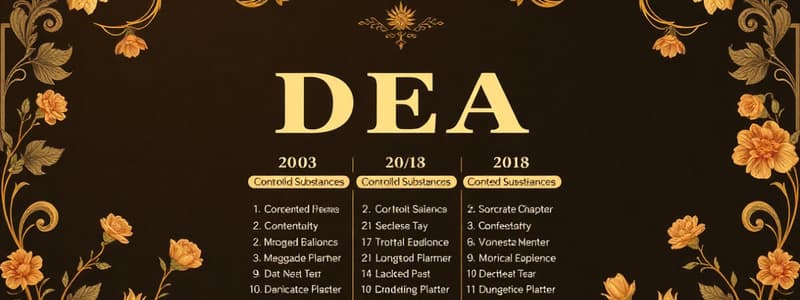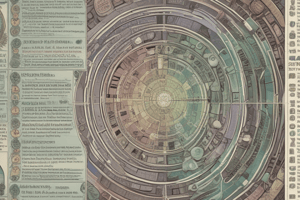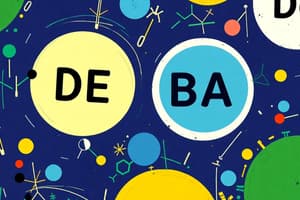Podcast
Questions and Answers
Which of the following Schedule drug classifications indicates substances with no accepted medical use and a high abuse potential?
Which of the following Schedule drug classifications indicates substances with no accepted medical use and a high abuse potential?
- Schedule IV
- Schedule III
- Schedule II
- Schedule I (correct)
A physician prescribes a medication that includes limited quantities of codeine for an antitussive purpose. Under which DEA schedule would this medication likely fall?
A physician prescribes a medication that includes limited quantities of codeine for an antitussive purpose. Under which DEA schedule would this medication likely fall?
- Schedule II
- Schedule I
- Schedule V (correct)
- Schedule III
Which statement best reflects the intent of the Florida Good Samaritan Act regarding healthcare practitioners?
Which statement best reflects the intent of the Florida Good Samaritan Act regarding healthcare practitioners?
- It applies solely to patients entering a facility via the emergency room or trauma center.
- It encourages healthcare practitioners to provide emergency care without fear of litigation. (correct)
- It only protects practitioners of emergency medicine against litigation in emergency situations.
- It offers blanket immunity for all actions performed in a healthcare setting, regardless of intent.
The Good Samaritan Act in Florida requires a plaintiff to demonstrate what level of disregard on the part of the healthcare provider to overcome its protections?
The Good Samaritan Act in Florida requires a plaintiff to demonstrate what level of disregard on the part of the healthcare provider to overcome its protections?
What is the primary focus of the Mini-Mental State Examination (MMSE)?
What is the primary focus of the Mini-Mental State Examination (MMSE)?
A clinician wants to assess a patient's likelihood of experiencing alcohol withdrawal and delirium tremens. Which assessment tool is most appropriate?
A clinician wants to assess a patient's likelihood of experiencing alcohol withdrawal and delirium tremens. Which assessment tool is most appropriate?
Which tool is most commonly used to screen for alcohol abuse?
Which tool is most commonly used to screen for alcohol abuse?
What is a key consideration when prescribing Clozapine?
What is a key consideration when prescribing Clozapine?
What lab monitoring is essential for patients taking lithium?
What lab monitoring is essential for patients taking lithium?
A patient taking lithium begins a low-sodium diet. What potential impact might this have on their lithium levels?
A patient taking lithium begins a low-sodium diet. What potential impact might this have on their lithium levels?
Which of the following is a common side effect associated with the use of SSRIs?
Which of the following is a common side effect associated with the use of SSRIs?
What is a primary concern when discontinuing paroxetine abruptly?
What is a primary concern when discontinuing paroxetine abruptly?
Which of the following best describes the action of benzodiazepines in the brain?
Which of the following best describes the action of benzodiazepines in the brain?
A patient presents with restlessness, agitation, hyperreflexia, and rapid heart rate after starting a new medication. What condition should be suspected?
A patient presents with restlessness, agitation, hyperreflexia, and rapid heart rate after starting a new medication. What condition should be suspected?
What is the MAIN focus of Dialectical Behavior Therapy (DBT)?
What is the MAIN focus of Dialectical Behavior Therapy (DBT)?
In motivational interviewing, what is the purpose of 'reflections'?
In motivational interviewing, what is the purpose of 'reflections'?
Which statement best characterizes the 'precontemplation' stage in the Transtheoretical Model of Change?
Which statement best characterizes the 'precontemplation' stage in the Transtheoretical Model of Change?
What neurotransmitter is MOST implicated in schizophrenia?
What neurotransmitter is MOST implicated in schizophrenia?
Which of Yalom's therapeutic factors involves participants realizing they are not alone in their struggles?
Which of Yalom's therapeutic factors involves participants realizing they are not alone in their struggles?
What is the primary goal of primary prevention efforts in mental health?
What is the primary goal of primary prevention efforts in mental health?
During an intake assessment, a patient reports persistent distrust and suspiciousness of others, interpreting their motives as malevolent. Which personality disorder is MOST suggested by this presentation?
During an intake assessment, a patient reports persistent distrust and suspiciousness of others, interpreting their motives as malevolent. Which personality disorder is MOST suggested by this presentation?
Which of the following best describes a key characteristic of schizoid personality disorder?
Which of the following best describes a key characteristic of schizoid personality disorder?
What is a distinguishing characteristic of Cluster B personality disorders compared to Clusters A and C?
What is a distinguishing characteristic of Cluster B personality disorders compared to Clusters A and C?
A patient consistently violates the rights of others, demonstrates a lack of remorse, and has a history of arrests for various offenses. Which personality disorder is most consistent with these behaviors?
A patient consistently violates the rights of others, demonstrates a lack of remorse, and has a history of arrests for various offenses. Which personality disorder is most consistent with these behaviors?
Which of the following is a key feature of avoidant personality disorder?
Which of the following is a key feature of avoidant personality disorder?
What is a key characteristic differentiating Obsessive-Compulsive Personality Disorder (OCPD) from Obsessive Compulsive Disorder (OCD)?
What is a key characteristic differentiating Obsessive-Compulsive Personality Disorder (OCPD) from Obsessive Compulsive Disorder (OCD)?
Which statement accurately describes a potential effect of heavy, chronic cannabis use?
Which statement accurately describes a potential effect of heavy, chronic cannabis use?
What is a notable physical symptom during cocaine intoxication?
What is a notable physical symptom during cocaine intoxication?
A patient with ADHD is being treated with stimulant medication. What is MOST important to monitor regularly?
A patient with ADHD is being treated with stimulant medication. What is MOST important to monitor regularly?
Which of the following accurately describes a consideration in prescribing vilazodone?
Which of the following accurately describes a consideration in prescribing vilazodone?
Which ethical principle is demonstrated when a healthcare provider ensures fairness in the allocation of resources and treatment options?
Which ethical principle is demonstrated when a healthcare provider ensures fairness in the allocation of resources and treatment options?
What distinguishes positive symptoms of schizophrenia from negative symptoms?
What distinguishes positive symptoms of schizophrenia from negative symptoms?
Which of the following is an example of a negative symptom in schizophrenia?
Which of the following is an example of a negative symptom in schizophrenia?
What baseline labs are recommended before initiating lithium treatment?
What baseline labs are recommended before initiating lithium treatment?
Which of Yalom's therapeutic factors from Irvin Yalom's group therapy theory most directly relates to participants gaining insight by observing and replicating successful behaviors exhibited by other members of the group?
Which of Yalom's therapeutic factors from Irvin Yalom's group therapy theory most directly relates to participants gaining insight by observing and replicating successful behaviors exhibited by other members of the group?
Flashcards
Schedule I Drugs
Schedule I Drugs
Schedule I drugs lack accepted medical use and have high abuse potential, like heroin, LSD, and marijuana.
Schedule II Drugs
Schedule II Drugs
Schedule II drugs have high abuse potential with severe psychological/physical dependence liability but have therapeutic utility. Examples include morphine and stimulants like Ritalin.
Schedule III Drugs
Schedule III Drugs
Schedule III drugs have less abuse potential than Schedules I and II, including codeine mixtures and ketamine.
Schedule IV Drugs
Schedule IV Drugs
Signup and view all the flashcards
Schedule V Drugs
Schedule V Drugs
Signup and view all the flashcards
Good Samaritan Act (Florida)
Good Samaritan Act (Florida)
Signup and view all the flashcards
Mini-Mental State Examination (MMSE)
Mini-Mental State Examination (MMSE)
Signup and view all the flashcards
Clinical Institute Withdrawal Assessment for Alcohol (CIWA)
Clinical Institute Withdrawal Assessment for Alcohol (CIWA)
Signup and view all the flashcards
CAGE Questionnaire
CAGE Questionnaire
Signup and view all the flashcards
AIMS (Abnormal Involuntary Movement Scale)
AIMS (Abnormal Involuntary Movement Scale)
Signup and view all the flashcards
Second-Generation Antipsychotics
Second-Generation Antipsychotics
Signup and view all the flashcards
Mood Stabilizers
Mood Stabilizers
Signup and view all the flashcards
SSRIs
SSRIs
Signup and view all the flashcards
SNRIs
SNRIs
Signup and view all the flashcards
Stimulants
Stimulants
Signup and view all the flashcards
Cluster A Personality Disorders
Cluster A Personality Disorders
Signup and view all the flashcards
Cluster B Personality Disorders
Cluster B Personality Disorders
Signup and view all the flashcards
Cluster C Personality Disorders
Cluster C Personality Disorders
Signup and view all the flashcards
Cognitive Behavioral Therapy (CBT)
Cognitive Behavioral Therapy (CBT)
Signup and view all the flashcards
Dialectical Behavior Therapy (DBT)
Dialectical Behavior Therapy (DBT)
Signup and view all the flashcards
Motivational Interviewing
Motivational Interviewing
Signup and view all the flashcards
Schizophrenia Positive Symptoms
Schizophrenia Positive Symptoms
Signup and view all the flashcards
Schizophrenia Negative Symptoms
Schizophrenia Negative Symptoms
Signup and view all the flashcards
Physical Effects of Cannabis
Physical Effects of Cannabis
Signup and view all the flashcards
Clozapine (Clozaril)
Clozapine (Clozaril)
Signup and view all the flashcards
Lithium
Lithium
Signup and view all the flashcards
Motivational Interviewing Techniques
Motivational Interviewing Techniques
Signup and view all the flashcards
Yalom's Therapeutic Factors
Yalom's Therapeutic Factors
Signup and view all the flashcards
MMSE (Mini-Mental State Examination)
MMSE (Mini-Mental State Examination)
Signup and view all the flashcards
Primary Prevention
Primary Prevention
Signup and view all the flashcards
Secondary Prevention
Secondary Prevention
Signup and view all the flashcards
Tertiary Prevention
Tertiary Prevention
Signup and view all the flashcards
Norepinephrine
Norepinephrine
Signup and view all the flashcards
Serotonin
Serotonin
Signup and view all the flashcards
Glutamate
Glutamate
Signup and view all the flashcards
GABA neurotransmitter
GABA neurotransmitter
Signup and view all the flashcards
Study Notes
DEA and Schedule Drug/Substance Levels
- There are five "schedules" of controlled substances based on their abuse potential and accepted medical use.
- Substances in Schedule I have a high abuse potential and no accepted medical use in the United States such as heroin, LSD, MDMA, marijuana, and peyote.
- Schedule II drugs have a high abuse potential, may lead to psychological or physical dependence, but have therapeutic utility like morphine, codeine, fentanyl, stimulants (Ritalin and Adderall).
- Schedule III drugs have less abuse potential than Schedules I and II and include limited quantities of codeine mixtures (Tylenol with codeine), ketamine, and anabolic steroids.
- Schedule IV drugs have less abuse potential than Schedule III and include Xanax, Soma, Valium, Ativan, Talwin, Ambien, and Tramadol.
- Schedule V drugs have the least abuse potential and include preparations containing limited quantities of certain narcotics/stimulants for antitussive, antidiarrheal, and analgesic purposes such as cough preparations with codeine, Lomotil, and Lyrica.
Good Samaritan Statute
- All 50 states have passed some version of the Good Samaritan Act to protect people from legal repercussions when assisting in emergency situations.
- Florida's Good Samaritan Act protects healthcare providers and encourages them to provide emergency care.
- Florida Statute 786.13 states the legislature's intent to encourage healthcare practitioners to provide necessary healthcare to all persons without fear of litigation.
- The statute protects healthcare practitioners and extends to physician assistants, nurses, and other extenders providing emergent care.
- An amendment in 2003 made it so the act is no longer only for people who entered through the emergency room.
- Under Florida Statute 768.13(2)(a)), healthcare practitioners providing emergency services are not liable for civil damages as a result of care/treatment.
- The act requires a high burden of proof, the health care provider acted with "reckless disregard for the consequences so as to affect the life or health of another".
- Reckless disregard includes conduct that a health care provider knew or should have known that it created an unreasonable risk of injury.
- Immunity extends to any act/omission of providing medical care, treatment, or diagnosis and care given before patient stabilization.
Rating Scales
- There are a variety of rating scales that can be used to assess and monitor mental health conditions
Mental Status (level of impairment)
- Mini-Mental State Examination (MMSE)
- Montreal Cognitive Assessment (MoCA)
- Mini-Cog
- St Louis University Mental Status Examination (SLUMS)
Depression
- Patient Health Questionnaire 9 (PHQ-9)
- Edinburgh Postnatal Depression Scale (EPDS)
- Beck Depression Inventory (BDI)
- Hamilton Depression Rating Scale (HAM-D)
Anxiety
- Zung's Self-Rating Anxiety Scale
- Hamilton Rating Scale for Anxiety
- Yale-Brown Obsessive Compulsive Scale
ADHD
- Conners' Parent and Teacher Rating Scales
- Vanderbilt ADHD Diagnostic Parent and Teacher Rating Scales
Schizophrenia
- Clinical outcome measures such as Positive and Negative Syndrome Scale (PANNS).
- Bief Psychiatric Rating Scale (BPRS)
- Scale for Assessment of Positive Symptoms (SAPS)
- Scale for Assessment of Negative Symptoms (SANS)
Assessment of abnormal movement rating scales
- Abnormal Involuntary Movement Scale (AIMS)
- Dyskinesia Identification System Condensed User Scale(DISCUS)
- Simpson-Angus Rating Scale (SAS)
Substance abuse
- CAGE - Screening tool in order to asses alcohol abuse (Cut down, Annoyed, Guilt, Eye-opener)
- AUDIT: Alcohol Use Disorders Identification Test
- S-MAST: Short Michigan Alcoholism Screening Test (or Geriatric Version)
- CRAFFT: Used for children and adolescents under 21 years of age
- COWS: The Clinical Opiate Withdrawal Scale
- CIWA is a tool used to determine likelihood of withdrawal (delirium tremens). Likelihood typically occurs in the first 24-72 hours from alcohol cessation.
- Assesses 10 common withdrawal symptoms (nausea/vomiting, tremors, paroxysmal sweats, anxiety, agitation, tactile disturbances, auditory disturbances, visual disturbances, headaches, altered sensorium)
Psychotropic Medications
- Be familiar with different categories and classes
Medications used to treat Schizophrenia and other psychotic disorders
- This class of drugs can be broken down into typical and second generation antipsychotics.
Typical Antipsychotics
- Haloperidol (Haldol), haloperidol decanoate (Haldol Decanoate)
- Loxapine (Loxitane)
- Thioridazine (Mellaril)
- Thiothixene (Navane)
- Fluphenazine (Prolixin), fluphenazine decanoate (Prolixin Decanoate)
- Mesoridazine (Serentil)
- Trifluoperazine (Stelazine)
- Chlorpromazine (Thorazine)
- Perphenazine (Trilafon)
Second-Generation Antipsychotics
- Clozapine (Clozaril)
- Ziprasidone (Geodon)
- Risperidone (Risperdal)
- Quetiapine (Seroquel)
- Olanzapine (Zyprexa)
- Aripiprazole (Abilify)
- Paliperidone (Invega)
- Iloperidone (Fanapt)
- Asenapine (Saphris)
- Lurasidone (Latuda)
Medications used to treat mood disorders and bipolar affective disorders
- Mood Stabilizers (Valproic acid (Depakene), Divalproex sodium (Depakote), Lithium carbonate, Lamotrigine (Lamictal))
- Treats Carbamazepine (Tegretol) & Oxcarbazepine (Trileptal; off-label)
Medications used to treat mood disorders, unipolar affective disorders, and depressive disorders
- Tricyclics (TCAS) (Clomipramine (Anafranil), Amoxapine (Asendin), Amitriptyline (Elavil)
- Treats Desipramine (Norpramin), Nortriptyline (Pamelor), Doxepin (Sinequan), Trimipramine (Surmontil) & Imipramine (Tofranil)
- Serotonin Selective Reuptake Inhibitors (SSRIs) (Citalopram (Celexa) Fluvoxamine (Luvox), Paroxetine (Paxil), Paroxetine mesylate (Pexeva))
- Treats Fluoxetine (Prozac), Sertraline (Zoloft), Escitalopram (Lexapro)
Monoamine Oxidase Inhibitors (MAOIs)
- Phenelzine (Nardil)
- Tranylcypromine sulfate (Parnate)
- Selegiline transdermal (EMSAM)
SNRIs and Other Agents
- Trazodone (Desyrel)
- Venlafaxine (Effexor)
- Desvenlafaxine (Pristiq)
- Mirtazapine (Remeron)
- Nefazodone (Serzone)
- Bupropion (Wellbutrin, Forfivo, Aplenzin)
- Duloxetine (Cymbalta)
- Vilazodone (Viibryd)
- Vortioxetine (Brintellix)
- Levomilnacipran (Fetzima)
Medications used to treat anxiety disorders
- Benzodiazepines (BNZs) (Lorazepam (Ativan), Clonazepam (Klonopin), Chlordiazepoxide (Librium))
- Treats Oxazepam (Serax), Clorazepate (Tranxene), & Alprazolam (Xanax) Treats Buspirone (BuSpar).
- Other Agents
- Propranolol (Inderal). and Atenolol (Tenormin)
Medications used to treat Attention Deficit Disorder and Attention Deficit Hyperactivity Disorder
- Stimulants (Amphetamine/dextroamphetamine (Adderall), Dexmethylphenidate (Focalin), Dextroamphetamine (Dexedrine))
- Treats Methylphenidate (Ritalin), Methylphenidate (Concerta), & Lisdexamfetamine dimesylate (Vyvanse) Treats Guanfacine (Intuniv) Other Agents (Clonidine (Kapvay), and Atomoxetine (Strattera)
- Antidepressants like desipramine (Norpramin), venlafaxine (Effexor), and bupropion (Wellbutrin) are also used sometimes.
Personality disorders
- Risk Factors
- Genetic loading
- Dysfunctional family of origin
Cluster A
- Pervasive distrust, suspiciousness, odd behavior
- Paranoid personality disorder (persistent, inappropriate suspiciousness and distrust of others)
- Schizoid personality disorder (Neither desires nor enjoys close relationships, Chooses solitary activities, Shows little to no interest in sexual activity with another person)
- Schizotypal personality disorder (Magical thinking, Unusual perceptual experiences, & Paranoid ideation)
Cluster B
- Cluster B = Patterns of interpersonal disruption, hospitalization possible during symptom expression
- Antisocial personality disorder (Failure to conform to social norms, Repeated acts that are grounds for arrest, Lack of remorse)
- Borderline personality disorder (Pattern of unstable, intense interpersonal relationships, Impulsivity (self-damaging behavior), & Recurrent suicidal behavior)
- Histrionic personality disorder (Uncomfortable in center of attention, inappropriate behavior, shallow emotions)
- Narcissistic personality disorder (Sense of self-importance, preoccupied with power, belief of self-importance)
Cluster C = Patterns of pervasive anxiety and fear
- Avoidant personality disorder (Avoidance of activities because of fear of disapproval, Preoccupation with being criticized)
- Dependent personality disorder (Difficulty disagreeing, Needing others to assume responsibility)
- Obsessive-compulsive personality disorder (Preoccupation with order, perfection, Overly conscientious)
SSRIs
- Fluoxetine (Prozac) (Useful with Olanzepine for acute depressive episodes in Bipolar I Disorder and treatment resistant depression)
- Sertraline (Zoloft) - Treats (MDD), (OCD), (PD), (PTSD), (SAD), (PMDD)
- Paroxetine (Paxil) - Treats (GAD) + (OCD), (PD), (SAD), (GAD), (PTSD). Short half life.
- Fuvoxamine (Luvox) - Treats OCD in children/adults. Short half life as well
- Citalopram (Celexa) - Dose-dependent QT prolongation
- Escitalopram (Lexapro) - Treats MDD and GAD
- Vilazodone (Viibryd)
- Vortioxetine (Trintellix)
SSRIs Side Effects
- anxiety, agitation, akathisia, insomnia, nausea, diarrhea, sexual dysfunction and hyponatremia (low sodium)
Serotonin and Discontinuation Syndrome.
- Serotonin Syndrome: Restlessness, agitation.
- Discontinuation Syndrome: flu like symptoms
Blackbox warnings for SSRIs
- Blackbox warnings for increased suicidality risk in children, adolescents, and young adults
CBT, DBT, Motivational Interviewing
CBT (Cognitive Behavior Therapy): Increase understanding of relationships between cognition and emotion, Decrease negativity
- DBT (Dialectical Behavior Therapy), focuses on emotional regulation, distress, management skills,
- Mindfulness, all emphasis of interfering behaviors.
- Transtheoretical Model of Change: Health behaviors occur in 6 stages.
- Precontemplation: no intention to change
- Contemplation: thinking about change, is aware
- Preparation: decision to change is made
- Action: specific actions to change
- Maintenance: prevent relapse
-
- Motivational interviewing: assess a person's willingness to engage in treatment.
Guiding to focus on"Change thinking"
- Focused, goal-directive therapy
- Builds on the Transtheoretical Model of Change= Motivational with client, and Non-confrontational.
Neurotransmitters
- Dopamine produced in the S. Nigra (substantia nigra)
- Norepinephrine produced in the locus ceruleus of pons, implicated in mood+Anxiety, in concentration disorders.
- Serotonin also from raphe nuclei of brainstem
- Glutamate Universal + Excitatory=Major ,and involved in process of kindling and epilepsy
- GABA Universal + Inhibitory= Site of action of benzodiazepine.
level with evidence
- Randomized controlled trials (RCT)
- Meta/systematic reviews
Labs to Monitor for 2nd Generation antipsychotic
- Blood glucose, Cholesterol
- Potential ECG, for long QT, with weight gain.
Ethical principles
-
- principles providing a foundation in decision-making in: Justice, Beneficence, Nonmaleficence Autonomy
Justice
- Doing what is fair within all aspects of care
Beneficence
- Well-being and doing good
Nonmaleficence
- Doing no harm
Fidelity
- Being true/loyal
Autonomy
- Doing for self
Varacity
- Truth telling
Respect
- Treating within equal respect
Schizophrenia
- Schizophrenia has + negative outcomes
Positive symptoms
- Relate to antipsychotic medication Caused by increased-dopamine
- Symptoms include:
- Hallucinations
- Delusions
- Referential thinking
- Disorganized behavior
- Hostility
- Suspisciousness
Negative symptoms
- Responds better to atypical antipsychotic medications. Cause=Decreased dopamine
- Symptoms include:
- Affective flattening
- Poverty of speech
- Avolition
- Apathy
- Abstract thinking difficulty
- Anhedonia
- Attention Deficits
Cocaine
With HIGH doses=Agitation+sexual behavior
Physical Effects of Cannabis Use
-
(Common) red dilated conjunctival vessels + increased appetite
-
(Heavy chronic use)= Impaired reactivity
-
Attention hyper-activity= Neurodevelopmental disorder.
Clozapine (Clozarill)
- For treatment resistant schizophrenia
- Must be enrolled in Clozapine REMS program
- Assessed in the ANC Absolute Neutrophil Count
- Levels 500-999/uL interrupt treatment, check ANC during and resume one ANC >1000UL
- Monitor for weight, circumference, sugar
- Monitor for family/personal history of + cardio
Lithium
- Gold standard for + treatment of manic episodes
- Mood + stabilizer, that treats for bi-polar disorder
- Potential toxicity, with serum levels + regular kidney function
- Narrow therepetuic
Levels > 1.2 increase risk for toxic side effects
Labs= Thyroid panel (creatinine and BUN)
- Pregnancy test (Epstein anomaly. ECG for >50. DO NOT MIX W/NSAID Hyponatremia can cause dehydration, + lithium concentration
- Can Decrease serum Lithium concentrations by administering + sodium
Benzodiazepines (Schedule IV)
- Short Term: (Alprazolam + Loreazepam). Class is anxiolytic medications with Gaba affects
Ml provides
Ways for + practitioners to communication.
- OPEN question : questions cant answer yes or no with short answers
- Affirmations: comments and strenghts
- Refflections: statements with content of feelings
Studying That Suits You
Use AI to generate personalized quizzes and flashcards to suit your learning preferences.




